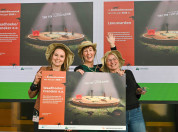Zoeken
Filteren op
Type
Labels
Dossiers
Thema's
Afdelingen
Taal
Active filters
1744 zoekresultaten
Zoekresultaten
-
Exploring Soil Biodiversity and ecosystem services through molecular and AI machine learning
An intern position for the EU Soil Missions Horizon 2020 project, "Integrating Soil Biodiversity into Ecosystem Services (SOB4ES). This internship will assist in generating primary data in the form of community compositions of mites and springtails with molecular approaches, AI machine learning and setting up eco-acoustic recording sample library. -
Exploring Soil Biodiversity and ecosystem services through molecular and AI machine learning
An intern position for the EU Soil Missions Horizon 2020 project, "Integrating Soil Biodiversity into Ecosystem Services (SOB4ES). This internship will assist in generating primary data in the form of community compositions of mites and springtails with molecular approaches, AI machine learning and setting up eco-acoustic recording sample library. -
PhD thesis defence Muhammad-Syamsu Rizaludin: Underground alarms
Muhammad-Syamsu Rizaludin will defend his PhD thesis, titled "Underground alarms: volatile-mediated recruitment of beneficial soil bacteria by plants under biotic stress".
-
PhD thesis defence Muhammad-Syamsu Rizaludin: Underground alarms
Muhammad-Syamsu Rizaludin will defend his PhD thesis, titled "Underground alarms: volatile-mediated recruitment of beneficial soil bacteria by plants under biotic stress".
-
PhD thesis defence Zhaoqi Bin: Application of trait-based plant-soil feedback for agroecosystem optimization
Zhaoqi Bin will defend her PhD thesis, titled "Application of trait-based plant-soil feedback for agroecosystem optimization".
-
PhD thesis defence Zhaoqi Bin: Application of trait-based plant-soil feedback for agroecosystem optimization
Zhaoqi Bin will defend her PhD thesis, titled "Application of trait-based plant-soil feedback for agroecosystem optimization".
-
Hbo/MSc student project: microbial N2O emission and CH4 oxidation in agricultural soil (vacature in het Engels)
Upland soils play an important role in climate regulation by acting as both sinks and sources of greenhouse gases (GHGs), such as nitrous oxide (N₂O) and methane (CH₄). Compared with natural upland ecosystems, agricultural soils often exhibit higher “leakiness” owing to intensive management practices such as high nitrogen inputs and frequent soil disturbances. These practices can reduce the CH₄ sink capacity while enhancing N₂O emissions. In a previous chapter of our work, we use extensive observational data to identify pathways through which agricultural practices may affect methane oxidation and nitrification. This student project will take an experimental approach to validate and extend those findings, linking management to soil GHG “leakiness” and the responsible microbial communities. -
Hbo/MSc student project: microbial N2O emission and CH4 oxidation in agricultural soil
Upland soils play an important role in climate regulation by acting as both sinks and sources of greenhouse gases (GHGs), such as nitrous oxide (N₂O) and methane (CH₄). Compared with natural upland ecosystems, agricultural soils often exhibit higher “leakiness” owing to intensive management practices such as high nitrogen inputs and frequent soil disturbances. These practices can reduce the CH₄ sink capacity while enhancing N₂O emissions. In a previous chapter of our work, we use extensive observational data to identify pathways through which agricultural practices may affect methane oxidation and nitrification. This student project will take an experimental approach to validate and extend those findings, linking management to soil GHG “leakiness” and the responsible microbial communities. -
Franeker en Leeuwarden winnen samen titel Bodemdierenstad van het Jaar
Normaal kan er maar ééntje winnen, maar ditmaal zijn het er twee. Zowel gemeente Leeuwarden als Waadhoeke – Franeker en omgeving – mag de eretitel Bodemdierenstad van het Jaar nu voeren. Zij lieten tijdens de Stedenbattle 2025 van het burgerwetenschapsproject de Bodemdierendagen in hoge mate zien hart te hebben voor bodemdieren en het belang van een gezonde bodem in de stad. Met name in Friesland dus.
-
Harnessing the seed microbiome for seed and plant performance under stress - MiSeed internship (vacature in het Engels)
The seed microbiome has gained increasing interest since it influences key aspects of plant life, including germination, seedling vigour, nutrient uptake, and tolerance to biotic and abiotic stresses. However, the microbial functions and molecular mechanisms that link seed-associated microbes to seed and plant performance remain largely unknown.
